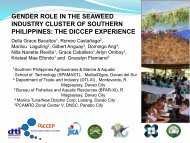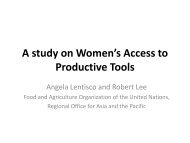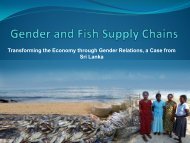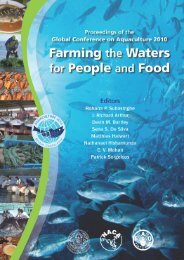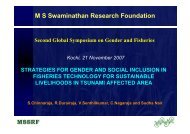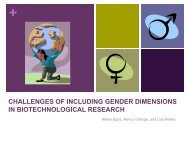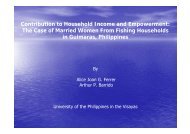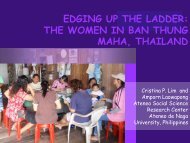Jariah Masud - GENDER IN AQUACULTURE AND FISHERIES
Jariah Masud - GENDER IN AQUACULTURE AND FISHERIES
Jariah Masud - GENDER IN AQUACULTURE AND FISHERIES
You also want an ePaper? Increase the reach of your titles
YUMPU automatically turns print PDFs into web optimized ePapers that Google loves.
POVERTY ERADICATION <strong>IN</strong> THEFISH<strong>IN</strong>G COMMUNITIES: <strong>GENDER</strong>PERSPECTIVEInstitute of Gerontology<strong>Jariah</strong> <strong>Masud</strong>, Ph.DTengku Aizan T.A.Hamid, Ph.D,Institute of Gerontology, UPMZumilah Zainallaludin, Ph.DIsmail Abd Latif, Ph. D.Mohamed Shariff, Ph.D,University Putra Malaysia.
Outline of presentation• Malaysia in brief• Poverty eradication strategies in Malaysia• The fishing sector• Poverty eradication programs in the fishingsector• Gender perspective in poverty eradicationInstitute of Gerontology
Malaysia’s Development Efforts3 National PoliciesThe New Economic Policy 1971 - 1990The National Development Policy 1991 - 2000The National Vision Policy 2001 - 20103 Outline Perspective Plans (OPP)OPP 1 1971 - 1990OPP 2 1991 - 2000OPP 3 2001 - 2010Institute of Gerontology
Poverty Eradication Strategies inMalaysiaInstitute of Gerontology
NATIONAL DEVELOPMENTPOLICY (1990-2000)NATIONAL ECONOMICPOLICY (1971-1990)POLICYNATIONAL VISIONARYPOLICY (2001-2010)BACKGROUNDPOVERTY RATES 1970 -49.3%Basic infrastructureHuman capital investmentRural developmentInstitute of GerontologyACHIEVEMENTPOVERTY RATES1990 – 16.5%Targeted poverty (Hard core)Urban povertyPOVERTY RATES 2004 -4.5%Pockets of povertyVulnerable groupRelative poverty
Institute of GerontologyThe Fishing Sector in Malaysia
160,000140,000120,000100,000Number of Fishermen, 2005-2009149,618140,405125,632120,904118,047111,344109,77197,947 99,61790,70280,00060,00040,00020,00020,642 20,100 21,28730,63423,986Fishing andAquacultureMarine FishingAquaculture (No)0Institute of Gerontology2005 2006 2007 2008 2009DOF, 2010
Quantity and Value of Marine FishMetric TonMillQuantityValueInstitute of Gerontology
Metric TonQuantity and Value of AquacultureMilQuantityValueValueInstitute of Gerontology
Third National Agriculture Policy (1998-2010)• Enhance food security• National income and export earning• Maximize income of the producers and• Poverty eradication• Fish Consumption:– 2000 - 49kg per capita– 2005 - 53kg per capita– 2010 - 56 kg per capitaInstitute of Gerontology
Agencies Responsible• Economic Planning Unit• Inter Agency Coordinating Unit (ICU)• Ministry of Agriculture.....– Department of Fisheries– Fisheries Development Board of Malaysia• Ministry of Rural and Regional Development• Ministry of Women, Family and CommunityDevelopment and many other MinistriesInstitute of Gerontology
Non Government• Fishermen’s Association (NEKMAT)• Amanah Ikhtiar Malaysia (Micro Credit NGO)• Religious based group• Sejahtera foundationInstitute of Gerontology
Programs for Fishing Sector 2010• Fishermen’s fund: December 2007, a total2,442 beneficiaries and 61 associationreceived the fund• Enriching fisheries resources: 421 locationbenefiting 50,000 fishermen• Aquaculture using fish protech system: 4states with 100 target• Diversifying fishermen’s income: 118 KUNITAwith 5,010 membersInstitute of Gerontology
Programs• Fish Landing facilities: 27 complexes and 108jetty built, benefiting 5,000 vessels• Village infrastructure: 15 projects involving2,978 houses• Village modernization: 750 fishermen in 4villages• Village infrastructure: 308 projects, 43,383beneficiaries.Institute of Gerontology
Poverty Eradication Programs inthe Fishing SectorInstitute of Gerontology
No Project Title Project Scope NumberKEDAH1 Income generating program Providing fishing gear 602 Aquaculture using fish protech system Fish rearing using fishtechnologyTERENGGANU1 Processing industry Income genarating 242 Poverty eradication: vulnerable group Fishing gear and food 100processing3 Poverty eradication:poor Fishing gear and food 50processingJOHOR1 Aquaculture using fish protech system Fish rearing using fish 100technology2 Poverty eradication: poor Fishing gear and food 50processingPERLIS1 Subsidy and incentives Fishing gear 29Institute of Gerontology
PAHANG Project Scope Number1 Aquaculture using fish protech system Fish rearing using fish100technology2 Poverty eradication:poor Fishing gear and food processing 50KELANTAN1 Aquaculture using fish protech system Fish rearing using fish300technology2 Resettlement Fishermen resettlement 300PERAK1 Poverty eradication: hard core poor Fishing gear and food processing 1002 Poverty eradication: poor Fishing gear and food processing 50SABAH1 Poverty eradication: poor and hard Fishing gear and food processing 100core poor1 Poverty eradication: hard core poor Fishing gear and food processing 100SARAWAK1 Poverty eradication program Fishing gear and food processing 100Institute of GerontologyFishery Development Authority Malaysia, 2010
Poverty in the Fishing SectorPLI (2009):Poor- RM660Hard core- RM275Institute of Gerontology
Poverty AmongFishermenPoorhouseholdHardcorepoorTotal FishermenHousehold IncomeSurvey 200420,695(29.7%)5,882(8.3%)69,680e-Kasih 2006 (povertydatabase)Traditional fishermen20081,604(38.2%)Bruit Island (2010) 1,668(93.7)2,036(9.0%)340(8.1%36(2%)22,7454,201 (total15,974)1,780Institute of Gerontology
Income Categories4001, 3759, 20%691-1000, 2952,15%2001-3000, 2817,15%1001-1500, 3842,20%1501-2000, 2457,13%Institute of GerontologySendi Report, 2007
Gender Perspective in PovertyEradicationInstitute of Gerontology
Gender Perspective• Poverty eradication programs targeted thehousehold heads (automatically men).• The gender perspective looks at theimpact of gender on people'sopportunities (men and women), socialroles and interactions• Poverty is a multi-dimentional socialproblem.Institute of Gerontology
Poverty As Social ProblemsIndividual:•Lack of skills•Absenteeism•Lack of capital•Under-employmentInstitute of GerontologyEnvironment•Lack of markets•Poor infrastructure•Poor leadership•Bad governanceThe factors:•Ignorance•Disease•Apathy•Dishonesty•Dependency
Gender Issues in Poverty Eradication• Fisher women marginalized, discriminated anddeprived of their rights to receive support sincefishermen=men (example: Bruit Island, Sarawak)due to gender stereotype.• Women’s roles invisible and unrecognized.• Focus on income poverty eradication only.• Women only program addressing practicalneeds, lack of integration in the mainstreamdevelopmentInstitute of Gerontology
Recommendations• Redefine poverty target: the head of households• Regards poverty as social problems• Focus on family as unit and identify the most atrisk persons and the potential contributors topoverty eradication program in the short termand long term to ensure sustainability.• Increase gender sensitivity among policy makers,program planners and researchers to rethinkassumption and practiceInstitute of Gerontology
Rethinking AssumptionRethinking PracticeGender-neutralInterventionsintended to leavedistribution ofresources andresponsibilities intactInstitute of GerontologyGender-sensitivepoliciesGenderredistributiveInterventionsintended to transformexisting distributionsin a more egalitariandirectionGender-specificInterventions intendedto meet targeted needsof one or other genderwithin resources andresponsibilities
Conclusions• Despite growth in the fishing sector inMalaysia, poverty remain a concern especiallyamong small scale aquaculture and fishingcommunities.• Lack of sex disaggregated and household datato enable better understanding of povertyamong fishing households.• Mainstreaming gender in the fishing sector.Institute of Gerontology
Institute of GerontologyThank you



